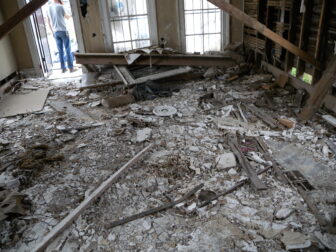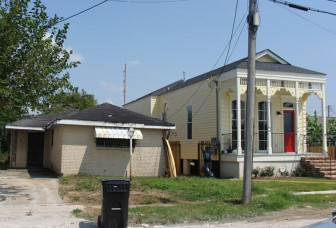Pete Becnel wasn’t sure he was going to hit it out of the park with a fixer-upper this far gone. But he had grown up watching his father, Dr. Harry Becnel, oversee the renovation of numerous houses in New Orleans and figured it was time to give the family tradition a try.
The outcome was a happy one, both for Becnel, 40, and for the neighborhood where he acquired one of the ruined houses moved during the snake-bitten program to save structures in the footprint of the city’s emerging bio-medical complex.
Ahead of a New Orleans Redevelopment Authority auction last March, the younger Becnel compiled a list of offerings that interested him. When a scheduling conflict meant he was going to miss the auction, he gave the list to his father. The idea was that they’d communicate by cell phone as the auction of 130 properties at the Morial Convention Center unfolded. But cell phone contact glitched out, and Dr. Becnel wound up buying a Mid City shotgun without his son’s final OK.
A licensed building contractor and father of two, Pete made it to the Convention Center as the auction was breaking up and left with a manilla folder filled with documents. “I saw everyone walking out with a manilla envelope that day,” he said, a sign that the auction had done a brisk business. The title transfer process went smoothly, and about two weeks later, the house at 4515 D’Hemecourt was officially his. Purchase price: $54,000.
Audio story on WWNO: ‘Boom and Blight in Mid-City‘
The house was old — one wing more than 150 years old — but it was new to D’Hemecourt Street, having been moved there to make room for the new LSU and Veteran’s Administration hospitals.
Trucking 81 houses to various locations around New Orleans was a much-touted effort by the Landrieu administration to appease preservationists appalled that site prep for the hospitals required bulldozing a 40-block neighborhood. The controversial Hail Mary salvage effort resulted in the destruction of several houses en route to new addresses and eventually inspired a flurry of lawsuits and countersuits fired off by the city; Builders of Hope, the North Carolina nonprofit that managed the project; subcontractor Tim Clark, and Orleans Shoring, the company that did the moving.
Spared the wrecking ball, many houses were moved successfully only to undergo a slow decline. Hauled across town, they stood for months without roofs or with missing walls. Wind, rain — and vandals — took their toll. Becnel’s was one of them, but 4515 D’Hemecourt stands as testament to the fact that some of those architectural refugees from the hospital site have survived.

Workers at a neighboring lumber yard teased Becnel about his purchase. They told him the house for a time stood in the street out front of the designated vacant lot and was open to the elements for months. And Becnel had his own moments of self-doubt as he began a renovation that only began with the need for fresh piers and an entirely new roof.
“Everything that’s up there, was down here, plastered to the floor,” Becnel said as he pointed towards the ceilings during a recent tour of the property.
The house is a hybrid, “a 100-year-old addition on a 150-year-old house,” he said. Becnel believes the back part of the house was a creole cottage and the front a three-bay shotgun added 50 years later.
Given that most of the interior was gutted, stolen or lost, Becnel is proud to point out that the front windows and floors are original. And “the floors are like stone,” he said. “I had a lot of workers going through saw blades while they worked on repairing them.”
Rehabbing the house took an additional investment of over $100,000 on top of the purchase price, not counting the work Becnel did himself and some still to be completed.
Six months after his auction purchase, he put the house on the market and within a 24-hour whirlwind — from listing to sales agreement in a single day — Becnel had an offer of $249,000. He took it.
Based on the number of inquiries, Becnel’s listing agent, Latter & Blum’s Sandy Parker, says she assumes there is pent-up demand for Mid-City houses in that price range.

A good thing, because blight has hardly disappeared with the uptick in the city’s housing market. The place right next door to Becnel’s rehab is open to the elements, a slab-on-grade structure with a hole cut in the roof, presumably the escape hatch used by occupants during the flooding after Hurricane Katrina when the federal levee system failed. The roof is a patchwork of varying colors, and the back door hangs open, providing a view of the gutted interior.
City records show the place was inspected in July 2012, but there is no reference to fines or liens against it on the assessor’s database.
Becnel says he called the city and had limited luck gathering information on the status of the property, he says his realtor made some calls too. He said he’s hopeful that the city will proceed with demolition.
“The city moved this house to the neighborhood when it was blighted,” Becnel says of the one he rebuilt and sold successfully. “Now that it’s fixed, I hope the city will act on the blight that was here when I purchased this house.”
City officials did not respond immediately to inquiries about the blighted house.
Meanwhile, Becnel is looking forward to bidding on another property next time the city auctions off another batch — maybe this time one with a roof.
The City Council will be holding a hearing on blight at 4pm today, in council chambers.

